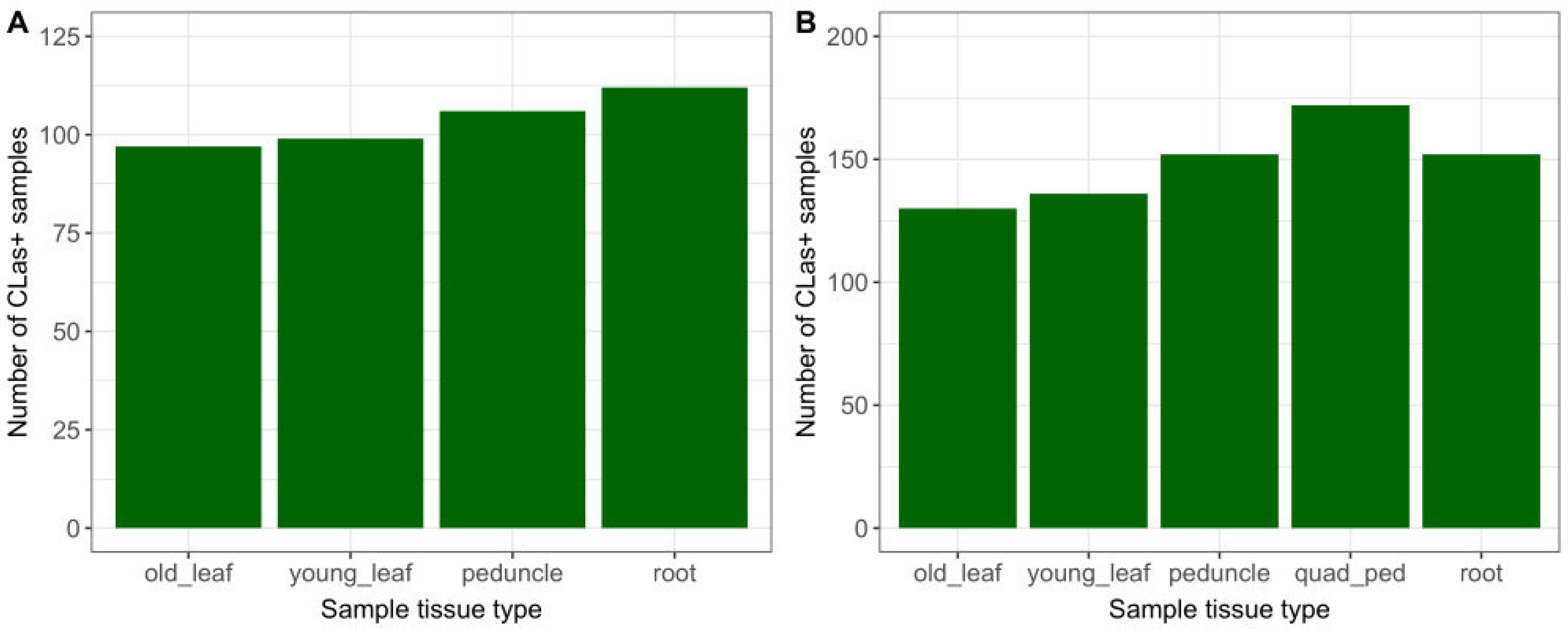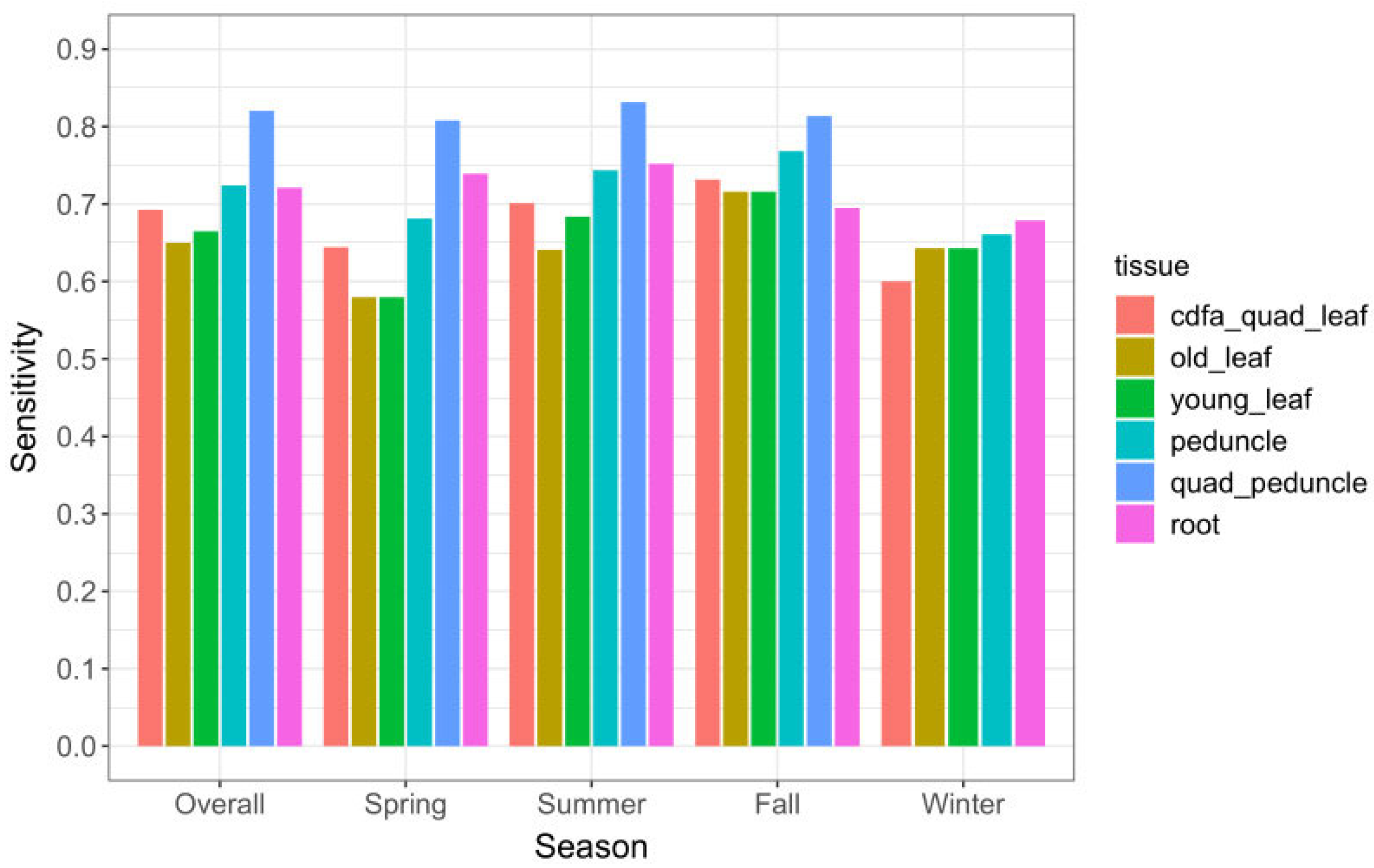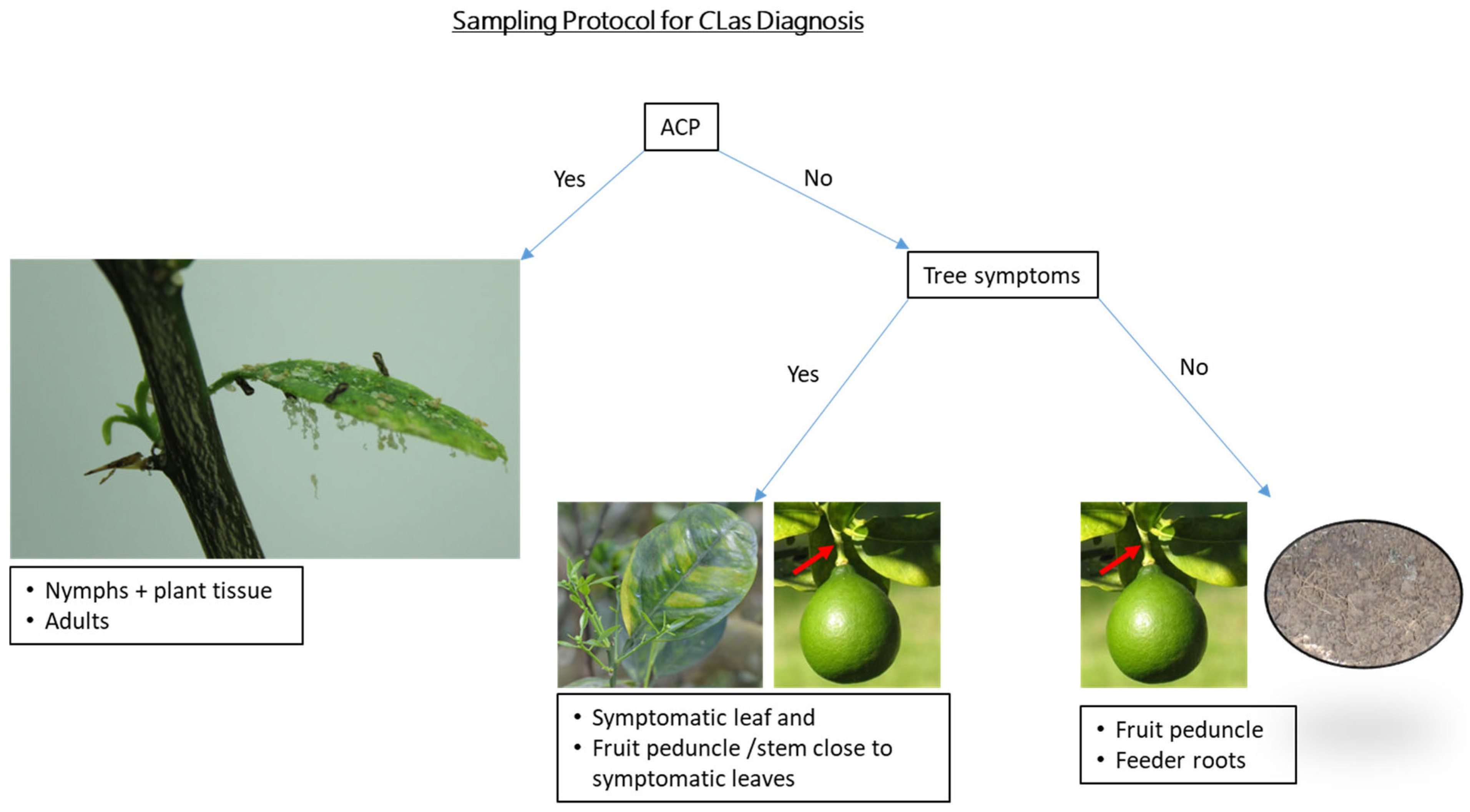Alternative Tissue Sampling for Improved Detection of Candidatus Liberibacter asiaticus
Abstract
1. Introduction
2. Results
2.1. CLas Detections by Tissue Type
2.2. Detection Sensitivity of Tissue Types and of Symptoms
2.2.1. Seasonal Effects
2.2.2. Statistical Models
3. Discussion
4. Materials and Methods
4.1. Plant Material
4.2. CLas Testing
4.3. Data Analysis
4.3.1. Detection Sensitivity of Tissue Types and of Symptoms
4.3.2. Seasonal Effects
4.3.3. Statistical Models
5. Conclusions
- Quadrant-peduncle (Q-P) tissue sampling consistently resulted in better CLas detection than any other tissue type.
- Q-P samples had a 30% higher qPCR positivity rate than quadrant-leaf (Q-L) samples.
- No significant seasonal patterns were observed.
- Roots and single peduncles had similar detection rates to each other; both were higher than single leaves or Q-L samples.
- If symptoms were used to guide sampling, 30% of infected trees would have been missed.
- Q-P tissue sampling is the optimal choice for improved CLas detection.
- Prioritizing ACP sampling for early CLas detection.
- If symptoms are found → sample the symptomatic tissue and, importantly, also sample nearby peduncle tissue.
- If symptoms are not present, but there is an indication of possible CLas exposure—e.g., nearby positive tree, nearby ACP finds, etc. → collect a quadrant-peduncle tissue sample.
- If all qPCR results are negative but follow-up sampling is required → sample root tissue for the follow-up. Although roots are not the most diagnostically sensitive tissue in general, there is some evidence that they may be preferable in cases where all aboveground tissue has tested negative.
Supplementary Materials
Author Contributions
Funding
Data Availability Statement
Acknowledgments
Conflicts of Interest
References
- Babcock, B.A. Economic Impact of California’s Citrus Industry in 2020. J. Citrus Pathol. 2022, 9. Published as a Special Topic in the Journal of Citrus Pathology, November 2021. [Google Scholar] [CrossRef]
- Bové, J.M. Huanglongbing: A destructive, newly-emerging, century-old disease of citrus. J. Plant Pathol. 2006, 88, 7–37. [Google Scholar]
- Gottwald, T.R. Current epidemiological understanding of citrus huanglongbing. Annu. Rev. Phytopathol. 2010, 48, 119–139. [Google Scholar] [CrossRef]
- Hodges, A.W.; Spreen, T.H. Economic Impacts of Citrus Greening (HLB) in Florida, 2006/07–2010/11: FE903/FE903, 1/2012. EDIS 2012, 2012, FE903. [Google Scholar] [CrossRef]
- California Department of Food and Agriculture. HLB Regulations and Quarantine Boundaries. 2023. Available online: https://www.cdfa.ca.gov/citrus/pests_diseases/hlb/regulation.html (accessed on 8 September 2023).
- Hughes, G.; Gottwald, T.R. Survey methods for assessment of citrus tristeza virus incidence. Phytopathology 1998, 88, 715–723. [Google Scholar] [CrossRef] [PubMed][Green Version]
- Madden, L.V.; Hughes, G. An effective sample size for predicting plant disease incidence in a spatial hierarchy. Phytopathology 1999, 89, 770–781. [Google Scholar] [CrossRef] [PubMed][Green Version]
- Futch, S.T.; Weingarten, S.H.; Irey, M. Determining HLB infection levels using multiple survey methods in Florida citrus. Proc. Fla. State Hortic. Soc. 2009, 122, 152–157. [Google Scholar]
- McCollum, G.; Hilf, M.; Irey, M. Relationship between Ct values, HLB symptoms and CLas titer. J. Citrus Pathol. 2014, 1, 97. [Google Scholar] [CrossRef]
- Singerman, A.; Useche, P. Impact of Citrus Greening on Citrus Operations in Florida; University of Florida/Institute of Food and Agricultural Sciences Extension: Gainesville, FL, USA, 2016; p. FE983. [Google Scholar]
- Zheng, Z.; Xu, M.; Bao, M.; Wu, F.; Chen, J.; Deng, X. Unusual five copies and dual forms of nrdB in “Candidatus Liberibacter asiaticus”: Biological implications and PCR detection application. Sci. Rep. 2016, 6, 39020. [Google Scholar] [CrossRef]
- Albrecht, C.; Hicks, A.; Hornbaker, V.; Khalid, S.; Kumagai, L.; Morgan, D.; Okasaki, K. Action plan for Asian Citrus Psyllid and Huanglongbing (citrus greening) in California. J. Citrus Pathol. 2020, 7. Published as a Special Topic in the Journal of Citrus Pathology, November 2020. [Google Scholar] [CrossRef]
- Tatineni, S.; Sagaram, U.S.; Gowda, S.; Robertson, C.J.; Dawson, W.O.; Iwanami, T.; Wang, N. In planta distribution of ‘Candidatus Liberibacter asiaticus’ as revealed by polymerase chain reaction (PCR) and real-time PCR. Phytopathology 2008, 98, 592–599. [Google Scholar] [CrossRef] [PubMed]
- Kunta, M.; da Graça, J.V.; Malik, N.S.; Louzada, E.S.; Sétamou, M. Quantitative distribution of Candidatus Liberibacter asiaticus in the aerial parts of the huanglongbing-infected citrus trees in Texas. HortScience 2014, 49, 65–68. [Google Scholar] [CrossRef]
- Louzada, E.S.; Vazquez, O.E.; Braswell, W.E.; Yanev, G.; Devanaboina, M.; Kunta, M. Distribution of ‘Candidatus Liberibacter asiaticus’ above and below ground in Texas citrus. Phytopathology 2016, 106, 702–709. [Google Scholar] [CrossRef] [PubMed]
- Park, J.W.; Louzada, E.S.; Braswell, W.E.; Stansly, P.A.; da Graça, J.V.; McCollum, G.; Rascoe, J.E.; Kunta, M. A new diagnostic real-time PCR method for huanglongbing detection in citrus root tissue. J. Gen. Plant Pathol. 2018, 84, 359–367. [Google Scholar] [CrossRef]
- Braswell, W.E.; Park, J.W.; Stansly, P.A.; Kostyk, B.C.; Louzada, E.S.; da Graça, J.V.; Kunta, M. Root samples provide early and improved detection of Candidatus Liberibacter asiaticus in Citrus. Sci. Rep. 2020, 10, 16982. [Google Scholar] [CrossRef]
- Irey, M.S.; Gast, T.; Cote, J.; Gadea, P.; Santiago, O.; Briefman, L.; Graham, J.H. Seasonal variability in HLB testing data in plant and psyllid samples in Florida. In Proceedings of the 2nd International Research Conference on Huanglongbing, Orlando, FL, USA, 10–14 January 2011; Burns, J.K., Graham, J.H., Gottwald, T.R., Eds.; Plant Management Network: St. Paul, MN, USA, 2011; Volume 6, p. 72. Available online: https://www.plantmanagementnetwork.org/proceedings/irchlb/2011/presentations/IRCHLB_2011_4.6.pdf (accessed on 21 September 2023).
- Gottwald, T.R.; Graça, J.V.D.; Bassanezi, R.B. Citrus huanglongbing: The pathogen and its impact. Plant Health Prog. 2007, 8, 31. [Google Scholar] [CrossRef]
- Bendix, C.; Lewis, J.D. The enemy within: Phloem-limited pathogens. Mol. Plant Pathol. 2018, 19, 238–254. [Google Scholar] [CrossRef]
- Braun, D.M. Phloem loading and unloading of sucrose: What a long, strange trip from source to sink. Annu. Rev. Plant Biol. 2022, 73, 553–584. [Google Scholar] [CrossRef]
- Lewis, J.D.; Knoblauch, M.; Turgeon, R. The phloem as an arena for plant pathogens. Annu. Rev. Phytopathol. 2022, 60, 77–96. [Google Scholar] [CrossRef]
- Münch, E. Die Stoffbewegungen in Der Pflanze; G. Fischer: Jena, Germany, 1930. [Google Scholar]
- Jensen, K.H.; Berg-Sørensen, K.; Bruus, H.; Holbrook, N.M.; Liesche, J.; Schulz, A.; Zwieniecki, M.A.; Bohr, T. Sap flow and sugar transport in plants. Rev. Mod. Phys. 2016, 88, 035007. [Google Scholar] [CrossRef]
- Bar-Joseph, M.; Garnsey, S.M.; Gonsalves, D.; Moscovitz, M.; Purcifull, D.E.; Clark, M.F.; Loebenstein, G. The use of enzyme-linked immunosorbent assay for detection of citrus tristeza virus. Phytopathology 1979, 69, 190–194. [Google Scholar] [CrossRef]
- Mello, A.F.; Yokomi, R.K.; Melcher, U.; Chen, J.; Civerolo, E.; Wayadande, A.C.; Fletcher, J. New perspectives on the epidemiology of citrus stubborn disease in California orchards. Plant Health Prog. 2010, 11, 37. [Google Scholar] [CrossRef]
- Gottwald, T.R.; Hughes, G. A new survey method for citrus tristeza virus disease assessment. Int. Organ. Citrus Virol. Conf. Proc. 2000, 14, 77–87. [Google Scholar] [CrossRef]
- R Core Team. R: A Language and Environment for Statistical Computing; R Foundation for Statistical Computing: Vienna, Austria, 2021; Available online: https://www.R-project.org/ (accessed on 1 July 2022).
- Manjunath, K.Á.; Halbert, S.E.; Ramadugu, C.H.; Webb, S.; Lee, R.F. Detection of ‘Candidatus Liberibacter asiaticus’ in Diaphorina citri and its importance in the management of citrus huanglongbing in Florida. Phytopathology 2008, 98, 387–396. [Google Scholar] [CrossRef] [PubMed]






| Type | N | % Pos (CLas+/Total) | Mean Ct Value |
|---|---|---|---|
| Trees | 408 | 89.7% (366/408) | NA |
| Sampling events | 765 | 48.2% (369/765) | NA |
| Tissue Samples | N | % Pos (CLas+/Total) | Mean Ct value |
| CDFA original sample a | 765 | Trees: 82.6% (337/408) Samples: 45.2% (346/765) | 26.5 |
| CDFA quadrant leaf b | 642 | 25.2% (162/642) | 25.7 |
| Old leaf | 765 | 29.7% (227/765) | 24.9 |
| Young leaf | 765 | 30.7% (235/765) | 25.2 |
| Single peduncle | 765 | 33.7% (258/765) | 24.8 |
| Quadrant peduncle c | 314 | 54.8% (172/314) | 26.0 |
| Root | 765 | 34.5% (264/765) | 26.7 |
| Tissue Sample | Overall | Spring | Summer | Fall | Winter |
|---|---|---|---|---|---|
| Study samples | |||||
| Old leaf | 65.6% (227/346) | 58.6% (41/70) | 63.3% (76/120) | 71.7% (71/99) | 68.4% (39/57) |
| Young leaf | 67.9% (235/346) | 58.6% (41/70) | 68.3% (82/120) | 72.7% (72/99) | 70.2% (40/57) |
| Single peduncle | 74.6% (258/346) | 68.6% (48/70) | 75.0% (90/120) | 78.8% (78/99) | 73.7% (42/57) |
| Quadrant peduncle | 83.5% (172/206) | 84.6% (44/52) | 83.2% (79/95) | 83.1% (49/59) | NA |
| Root | 76.3% (264/346) | 75.7% (53/70) | 78.3% (94/120) | 74.7% (74/99) | 75.4% (43/57) |
| CDFA samples collected at the same time point as study samples | |||||
| CDFA Quadrant leaf | 72.3% (162/224) | 64.4% (38/59) | 69.7% (62/89) | 71.4% (50/70) | 66.7% (4/6) |
| Symptoms | Plant Sample Tissue | Total | |
|---|---|---|---|
| Pos | Neg | ||
| Yes | 182 | 146 | 328 |
| No | 78 | 195 | 273 |
| Total | 260 | 341 | 601 |
| Q-L | Study Sample Tissue | Total | |
|---|---|---|---|
| Pos | Neg | ||
| Pos | 162 | 1 | 163 |
| Neg | 69 | 410 | 479 |
| Total | 231 | 411 | 642 |
| Parameter | OR (95% CI) | p |
|---|---|---|
| Model 1: qPCR result (pos/neg)~tissue sample type (excl. quadrant peduncle) | ||
| CDFA-collected old leaf | 1.00 (reference) | NA |
| Old leaf (study sample) | 1.07 (0.85–1.33) | 0.57 |
| Young leaf | 1.12 (0.90–1.40) | 0.31 |
| Peduncle | 1.29 (1.03–1.60) | 0.020 * |
| Root | 1.33 (1.07–1.65) | 0.0097 ** |
| Model 2: qPCR result (pos/neg)~tissue sample type (incl. quadrant peduncle) | ||
| CDFA-collected old leaf | 1.00 (reference) | NA |
| Old leaf (study sample) | 1.01 (0.74–1.39) | 0.94 |
| Young leaf | 1.10 (0.80–1.50) | 0.57 |
| Peduncle | 1.35 (0.98–1.85) | 0.065 |
| Quadrant peduncle | 1.74 (1.27–2.39) | 0.00062 *** |
| Root | 1.35 (0.98–1.85) | 0.065 |
Disclaimer/Publisher’s Note: The statements, opinions and data contained in all publications are solely those of the individual author(s) and contributor(s) and not of MDPI and/or the editor(s). MDPI and/or the editor(s) disclaim responsibility for any injury to people or property resulting from any ideas, methods, instructions or products referred to in the content. |
© 2023 by the authors. Licensee MDPI, Basel, Switzerland. This article is an open access article distributed under the terms and conditions of the Creative Commons Attribution (CC BY) license (https://creativecommons.org/licenses/by/4.0/).
Share and Cite
Hajeri, S.; Olkowski, S.; Kumagai, L.; McRoberts, N.; Yokomi, R.K. Alternative Tissue Sampling for Improved Detection of Candidatus Liberibacter asiaticus. Plants 2023, 12, 3364. https://doi.org/10.3390/plants12193364
Hajeri S, Olkowski S, Kumagai L, McRoberts N, Yokomi RK. Alternative Tissue Sampling for Improved Detection of Candidatus Liberibacter asiaticus. Plants. 2023; 12(19):3364. https://doi.org/10.3390/plants12193364
Chicago/Turabian StyleHajeri, Subhas, Sandra Olkowski, Lucita Kumagai, Neil McRoberts, and Raymond K. Yokomi. 2023. "Alternative Tissue Sampling for Improved Detection of Candidatus Liberibacter asiaticus" Plants 12, no. 19: 3364. https://doi.org/10.3390/plants12193364
APA StyleHajeri, S., Olkowski, S., Kumagai, L., McRoberts, N., & Yokomi, R. K. (2023). Alternative Tissue Sampling for Improved Detection of Candidatus Liberibacter asiaticus. Plants, 12(19), 3364. https://doi.org/10.3390/plants12193364







